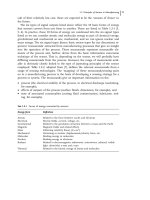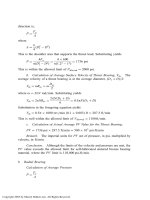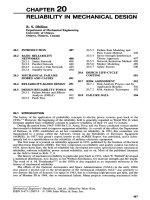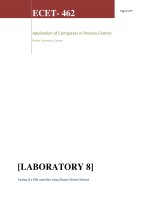Understanding Probability: Chance Rules in Everyday Life pptx
Bạn đang xem bản rút gọn của tài liệu. Xem và tải ngay bản đầy đủ của tài liệu tại đây (3.19 MB, 454 trang )
This page intentionally left blank
Understanding Probability
Chance events are commonplace in our daily lives. Every day we face situations where
the result is uncertain, and, perhaps without realizing it, we guess about the likelihood
of one outcome or another. Fortunately, mastering the concepts of probability can cast
new light on situations where randomness and chance appear to rule.
In this fully revised second edition of Understanding Probability, the reader can
learn about the world of probability in an appealing way. The author demystifies the
law of large numbers, betting systems, random walks, the bootstrap, rare events, the
central limit theorem, the Bayesian approach, and more.
This second edition has wider coverage, more explanations and examples and
exercises, and a new chapter introducing Markov chains, making it a great choice for a
first probability course. But its easy-going style makes it just as valuable if you want to
learn about the subject on your own, and high school algebra is really all the
mathematical background you need.
Henk Tijms is Professor of Operations Research at the Vrije University in
Amsterdam. The author of several textbooks, including A First Course in Stochastic
Models, he is intensively active in the popularization of applied mathematics and
probability in Dutch high schools. He has also written numerous papers on applied
probability and stochastic optimization for international journals, including Applied
Probability and Probability in the Engineering and Informational Sciences.
Understanding Probability
Chance Rules in Everyday Life
Second Edition
HENK TIJMS
Vrije University
CAMBRIDGE UNIVERSITY PRESS
Cambridge, New York, Melbourne, Madrid, Cape Town, Singapore, São Paulo
Cambridge University Press
The Edinburgh Building, Cambridge CB2 8RU, UK
First published in print format
ISBN-13 978-0-521-70172-3
ISBN-13 978-0-511-34917-1
© H. Tijms 2007
2007
Information on this title: www.cambridge.org/9780521701723
This publication is in copyright. Subject to statutory exception and to the provision of
relevant collective licensing agreements, no reproduction of any part may take place
without the written
p
ermission of Cambrid
g
e University Press.
ISBN-10 0-511-34917-3
ISBN-10 0-521-70172-4
Cambridge University Press has no responsibility for the persistence or accuracy of urls
for external or third-party internet websites referred to in this publication, and does not
g
uarantee that any content on such websites is, or will remain, accurate or a
pp
ro
p
riate.
Published in the United States of America by Cambridge University Press, New York
www.cambridge.org
paperback
eBook (EBL)
eBook (EBL)
paperback
Contents
Preface page ix
Introduction 1
PART ONE: PROBABILITY IN ACTION 9
1 Probability questions 11
2 The law of large numbers and simulation 17
2.1 The law of large numbers for probabilities 18
2.2 Basic probability concepts 27
2.3 Expected value and the law of large numbers 32
2.4 The drunkard’s walk 37
2.5 The St. Petersburg paradox 39
2.6 Roulette and the law of large numbers 41
2.7 The Kelly betting system 44
2.8 Random-number generator 50
2.9 Simulating from probability distributions 55
2.10 Problems 64
3 Probabilities in everyday life 73
3.1 The birthday problem 74
3.2 The coupon collector’s problem 79
3.3 Craps 82
3.4 Gambling systems for roulette 86
3.5 The 1970 draft lottery 89
3.6 Bootstrap method 93
3.7 Problems 95
v
vi Contents
4 Rare events and lotteries 103
4.1 The binomial distribution 104
4.2 The Poisson distribution 108
4.3 The hypergeometric distribution 125
4.4 Problems 134
5 Probability and statistics 141
5.1 The normal curve 143
5.2 The concept of standard deviation 151
5.3 The square-root law 159
5.4 The central limit theorem 160
5.5 Graphical illustration of the central limit
theorem 164
5.6 Statistical applications 166
5.7 Confidence intervals for simulations 170
5.8 The central limit theorem and random walks 177
5.9 Falsified data and Benford’s law 191
5.10 The normal distribution strikes again 196
5.11 Statistics and probability theory 197
5.12 Problems 200
6 Chance trees and Bayes’ rule 206
6.1 The Monty Hall dilemma 207
6.2 The test paradox 212
6.3 Problems 217
PART TWO: ESSENTIALS OF PROBABILITY 221
7 Foundations of probability theory 223
7.1 Probabilistic foundations 223
7.2 Compound chance experiments 231
7.3 Some basic rules 235
8 Conditional probability and Bayes 243
8.1 Conditional probability 243
8.2 Bayes’ rule in odds form 251
8.3 Bayesian statistics 256
9 Basic rules for discrete random variables 263
9.1 Random variables 263
Contents vii
9.2 Expected value 264
9.3 Expected value of sums of random variables 268
9.4 Substitution rule and variance 270
9.5 Independence of random variables 275
9.6 Special discrete distributions 279
10 Continuous random variables 284
10.1 Concept of probability density 285
10.2 Important probability densities 296
10.3 Transformation of random variables 308
10.4 Failure rate function 310
11 Jointly distributed random variables 313
11.1 Joint probability densities 313
11.2 Marginal probability densities 319
11.3 Transformation of random variables 323
11.4 Covariance and correlation coefficient 327
12 Multivariate normal distribution 331
12.1 Bivariate normal distribution 331
12.2 Multivariate normal distribution 339
12.3 Multidimensional central limit theorem 342
12.4 The chi-square test 348
13 Conditional distributions 352
13.1 Conditional probability densities 352
13.2 Law of conditional probabilities 356
13.3 Law of conditional expectations 361
14 Generating functions 367
14.1 Generating functions 367
14.2 Moment-generating functions 374
15 Markov chains 385
15.1 Markov model 386
15.2 Transient analysis of Markov chains 394
15.3 Absorbing Markov chains 398
15.4 Long-run analysis of Markov chains 404
viii Contents
Appendix Counting methods and e
x
415
Recommended reading 421
Answers to odd-numbered problems 422
Bibliography 437
Index 439
Preface
When I was a student, a class in topology made a great impression on me. The
teacher asked me and my classmates not to take notes during the first hour of
his lectures. In that hour, he explained ideas and concepts from topology in a
nonrigorous, intuitive way. All we had to do was listen in order to grasp the
concepts being introduced. In the second hour of the lecture, the material from
the first hour was treated in a mathematically rigorous way and the students
were allowed to take notes. I learned a lot from this approach of interweaving
intuition and formal mathematics.
This book, about probability as it applies to our daily lives, is written very
much in the same spirit. It introduces the reader to the world of probability
in an informal way. It is not written in a theorem-proof style. Instead, it aims
to teach the novice the concepts of probability through the use of motivating
and insightful examples. In the book, no mathematics are introduced without
specific examples and applications to motivate the theory. Instruction is driven
by the need to answer questions about probability problems that are drawn
from real-world contexts. Most of the book can easily be read by anyone who
is not put off by a few numbers and some high school algebra. The informal
yet precise style of the book makes it suited for classroom use, particularly
when more self-activation is required from students. The book is organized into
chapters that may be understood if read in a nonlinear order. The concepts and
the ideas are laid out in the first part of the book, while the second part covers the
mathematical background. In the second part of the book, I have chosen to give
a short account of the mathematics of the subject by highlighting the essentials
in about 200 pages, which I believe better contributes to the understanding
of the student than a diffuse account of many more pages. The book can be
used for a one-quarter or one-semester course in a wide range of disciplines
ranging from social sciences to engineering. Also, it is an ideal book to use as
a supplementary text in more mathematical treatments of probability.
ix
x Preface
The book distinguishes itself from other introductory probability texts by
its emphasis on why probability works and how to apply it. Simulation in
interaction with theory is the perfect instrument to clarify and to enliven the
basic concepts of probability. For this reason, computer simulation is used to
give the reader insights into such key concepts as the law of large numbers,
which come to life through the results of many simulation trials. The law of
large numbers and the central limit theorem are at the center of the book, with
numerous examples based on these main themes. Many of the examples deal
with lotteries and casino games. The examples help the reader develop a “feel
for probabilities.” Good exercises are an essential part of each textbook. Much
care has been paid to collecting exercises that appeal to the understanding and
creativity of the reader rather than requiring the reader to plug numbers into
formulas. Several of the examples and exercises in this book are inspired by
material from the website of “Chance News.” This website contains a wealth of
material on probability and statistics. Finally, the text is enlivened with cartoons
combining chance and humor, which were supplied by www.cartoonstock.com.
New to this edition
The first edition of the book was very well received, notably by people from out-
side the field of mathematics. Many readers expressed in their correspondence
that they enjoyed the style of the book with its Parts One and Two, where the
informal Part One motivates probabilistic thinking through many fascinating
examples and problems from the real world and Part Two teaches the more for-
mal mathematics. The comments and recommendations helped me to improve
the book further. Part One has remained largely the same, but Part Two has
been changed and expanded. The second part has been made self-contained
for a first course in probability by adding more explanations and examples in
almost every chapter. Also, the second part has been expanded by adding an
introductory chapter on Markov chains, particularly suited for students in com-
puter science and engineering. In the same style as the other chapters, the topic
of Markov chains is taught by presenting interesting and realistic examples.
A solutions manual containing solutions to all of the exercises was prepared
for instructors. Finally, educational software supporting this book can be freely
downloaded from />Introduction
It is difficult to say who had a greater impact on the mobility of goods in
the preindustrial economy: the inventor of the wheel or the crafter of the first
pair of dice. One thing, however, is certain: the genius that designed the first
random-number generator, like the inventor of the wheel, will very likely remain
anonymous forever. We do know that the first dice-like exemplars were made a
very long time ago. Excavations in the Middle East and in India reveal that dice
were already in use at least fourteen centuries before Christ. Earlier still, around
3500 B.C., a board game existed in Egypt in which players tossed four-sided
sheep bones. Known as the astragalus, this precursor to the modern-day die
remained in use right up to the Middle Ages.
In the sixteenth century, the game of dice, or craps as we might call it today,
was subjected for the first time to a formal mathematical study by the Italian
mathematician and physician Gerolamo Cardano (1501–1576). An ardent gam-
bler, Cardano wrote a handbook for gamblers entitled Liber de Ludo Aleae (The
1
2 Introduction
Book of Games of Chance) about probabilities in games of chance. Cardano
originated and introduced the concept of the set of outcomes of an experi-
ment, and for cases in which all outcomes are equally probable, he defined the
probability of any one event occurring as the ratio of the number of favorable
outcomes and the total number of possible outcomes. This may seem obvious
today, but in Cardano’s day such an approach marked an enormous leap forward
in the development of probability theory. This approach, along with a correct
counting of the number of possible outcomes, gave the famous astronomer and
physicist Galileo Galilei the tools he needed to explain to the Grand Duke of
Tuscany, his benefactor, why it is that when you toss three dice, the chance of
the sum being 10 is greater than the chance of the sum being 9 (the probabilities
are
27
216
and
25
216
, respectively).
By the end of the seventeenth century, the Dutch astronomer Christiaan
Huygens (1625–1695) laid the foundation for current probability theory. His
text Van Rekeningh in Spelen van Geluck (On Reasoning in Games of Chance),
published in 1660, had enormous influence on later developments in probabil-
ity theory (this text had already been translated into Latin under the title De
Ratiociniis de Ludo Aleae in 1657). It was Huygens who originally introduced
the concept of expected value, which plays such an important role in probabil-
ity theory. His work unified various problems that had been solved earlier by
the famous French mathematicians Pierre Fermat and Blaise Pascal. Among
these was the interesting problem of how two players in a game of chance
should divide the stakes if the game ends prematurely. Huygens’ work led the
field for many years until, in 1713, the Swiss mathematician Jakob Bernoulli
(1654–1705) published Ars Conjectandi (The Art of Conjecturing) in which he
presented the first general theory for calculating probabilities. Then, in 1812,
the great French mathematician Pierre Simon Laplace (1749–1827) published
his Th
´
eorie Analytique des Probabilit
´
es. This book unquestionably represents
the greatest contribution in the history of probability theory.
Fermat and Pascal established the basic principles of probability in their
brief correspondence during the summer of 1654, in which they considered
some of the specific problems of odds calculation that had been posed to them
by gambling acquaintances. One of the more well known of these problems is
that of the Chevalier de M´er´e, who claimed to have discovered a contradiction
in arithmetic. De M´er´e knew that it was advantageous to wager that a six would
be rolled at least one time in four rolls of one die, but his experience as gambler
taught him that it was not advantageous to wager on a double six being rolled
at least one time in 24 rolls of a pair of dice. He argued that there were six
possible outcomes for the toss of a single die and 36 possible outcomes for the
toss of a pair of dice, and he claimed that this evidenced a contradiction to the
Introduction 3
arithmetic law of proportions, which says that the ratio of 4 to 6 should be the
same as 24 to 36. De M´er´e turned to Pascal, who showed him with a few simple
calculations that probability does not follow the law of proportions, as De M´er´e
had mistakenly assumed (by De M´er´e’s logic, the probability of at least one
head in two tosses of a fair coin would be 2 × 0.5 = 1, which we know cannot
be true). In any case, De M´er´e must have been an ardent player in order to have
established empirically that the probability of rolling at least one double six
in 24 rolls of a pair of dice lies just under one-half. The precise value of this
probability is 0.4914. The probability of rolling at least one six in four rolls of a
single die can be calculated as 0.5177. Incidentally, you may find it surprising
that four rolls of a die are required, rather than three, in order to have about an
equal chance of rolling at least one six.
Modern probability theory
Although probability theory was initially the product of questions posed by
gamblers about their odds in the various games of chance, in its modern form, it
has far outgrown any boundaries associated with the gaming room. These days,
probability theory plays an increasingly greater roll in many fields. Countless
problems in ourdaily lives call fora probabilistic approach. Inmany cases, better
judicial and medical decisions result from an elementary knowledge of prob-
ability theory. It is essential to the field of insurance.
†
And likewise, the stock
market, “the largest casino in the world,” cannot do without it. The telephone
network with its randomly fluctuating load could not have been economically
designed without the aid of probability theory. Call-centers and airline com-
panies apply probability theory to determine how many telephone lines and
service desks will be needed based on expected demand. Probability theory is
also essential in stock control to find a balance between the stock-out probabil-
ity and the costs of holding inventories in an environment of uncertain demand.
Engineers use probability theory when constructing dikes to calculate the prob-
ability of water levels exceeding their margins; this gives them the information
they need to determine optimum dike elevation. These examples underline the
extent to which the theory of probability has become an integral part of our
lives. Laplace was right when he wrote almost 200 years ago in his Th´eorie
Analytique des Probabilit´es:
The theory of probabilities is at bottom nothing but common sense reduced to
calculus; it enables us to appreciate with exactness that which accurate minds feel
†
Actuarial scientists have been contributing to the development of probability theory since its
early stages. Also, astronomers have played very important roles in the development of
probability theory.
4 Introduction
with a sort of instinct for which ofttimes they are unable to account It teaches
us to avoid the illusions which often mislead us; there is no science more
worthy of our contemplations nor a more useful one for admission to our system of
public education.
Probability theory and simulation
In terms of practical range, probability theory is comparable with geometry;
both are branches of applied mathematics that are directly linked with the prob-
lems of daily life. But while pretty much anyone can call up a natural feel for
geometry to some extent, many people clearly have trouble with the develop-
ment of a good intuition for probability. Probability and intuition do not always
agree. In no other branch of mathematics is it so easy to make mistakes as in
probability theory. The development of the foundations of probability theory
took a long time and went accompanied with ups and downs. The reader facing
difficulties in grasping the concepts of probability theory might find comfort in
the idea that even the genius Gottfried von Leibniz (1646–1716), the inventor of
differential and integral calculus along with Newton, had difficulties in calculat-
ing the probability of throwing 11with one throw of two dice. Probability theory
is a difficult subject to get a good grasp of, especially in a formal framework.
The computer offers excellent possibilities for acquiring a better understanding
of the basic ideas of probability theory by means of simulation. With computer
simulation, a concrete probability situation can be imitated on the computer.
The simulated results can then be shown graphically on the screen. The graphic
clarity offered by such a computer simulation makes it an especially suitable
means to acquiring a better feel for probability. Not only a didactic aid, com-
puter simulation is also a practical tool for tackling probability problems that
are too complicated for scientific solution. Computer simulation, for example,
has made it possible to develop winning strategies in the game of blackjack.
An outline
Part One of the book comprises Chapters 1–6. These chapters introduce the
reader to the basic concepts of probability theory by using motivating examples
to illustrate the concepts. A “feel for probabilities” is first developed through
examples that endeavor to bring out the essence of probability in a compelling
way. Simulation is a perfect aid in this undertaking of providing insight into
the hows and whys of probability theory. We will use computer simulation,
when needed, to illustrate subtle issues. The two pillars of probability theory,
namely, the law of large numbers and the central limit theorem receive in-depth
treatment. The nature of these two laws is best illustrated through the coin-toss
Introduction 5
experiment. The law of large numbers says that the percentage of tosses to come
out heads will be as close to 0.5 as you can imagine provided that the coin is
tossed often enough. How often the coin must be tossed in order to reach a
prespecified precision for the percentage can be identified with the central limit
theorem.
In Chapter 1, readers first encounter a series of intriguing problems to test
their feel for probabilities. These problems will all be solved in the ensuing
chapters. In Chapter 2, the law of large numbers provides the central theme. This
law makes a connection between the probability of an event in an experiment
and the relative frequency with which this event will occur when the experiment
is repeated a very large number of times. Formulated by the aforementioned
Jakob Bernoulli, the law of large numbers forms the theoretical foundation
under the experimental determination of probability by means of computer
simulation. The law of large numbers is clearly illuminated by the repeated
coin-toss experiment, which is discussed in detail in Chapter 2. Astonishing
results hold true in this simple experiment, and these results blow holes in many
a mythical assumption, such as the “hot hand” in basketball. One remarkable
application of the law of large numbers can be seen in the Kelly formula, a
betting formula that can provide insight for the making of horse racing and
investment decisions alike. The basic principles of computer simulation will
also be discussed in Chapter 2, with emphasis on the subject of how random
numbers can be generated on the computer.
In Chapter 3, we will tackle a number of realistic probability problems. Each
problem will undergo two treatments, the first one being based on computer
simulation and the second bearing the marks of a theoretical approach. Lotter-
ies and casino games are sources of inspiration for some of the problems in
Chapter 3.
The binomial distribution, the Poisson distribution, and the hypergeometric
distribution are the subjects of Chapter 4. We will discuss which of these impor-
tant probability distributions appliesto which probability situations, and we will
take a look into the practical importance of the distributions. Once again, we
look to the lotteries to provide us with instructional and entertaining examples.
We will see, in particular, how important the sometimes underestimated Pois-
son distribution, named after the French mathematician Sim´eon-Denis Poisson
(1781–1840), really is.
In Chapter 5, two more fundamental principles of probability theory and
statistics will be introduced: the central limit theorem and the normal distribu-
tion with its bell-shaped probability curve. The central limit theorem is by far
the most important product of probability theory. The names of the mathemati-
cians Abraham de Moivre and Pierre Simon Laplace are inseparably linked to
6 Introduction
this theorem and to the normal distribution. De Moivre discovered the normal
distribution around 1730.
†
An explanation of the frequent occurrence of this
distribution is provided by the central limit theorem. This theorem states that
data influenced by many small and unrelated random effects are approximately
normally distributed. It has been empirically observed that various natural phe-
nomena, such as the heights of individuals, intelligence scores, the luminosity
of stars, and daily returns of the S&P, follow approximately a normal distribu-
tion. The normal curve is also indispensable in quantum theory in physics. It
describes the statistical behavior of huge numbers of atoms or electrons. A great
many statistical methods are based on the central limit theorem. For one thing,
this theorem makes it possible for us to evaluate how (im)probable certain devi-
ations from the expected value are. For example, is the claim that heads came
up 5,250 times in 10,000 tosses of a fair coin credible? What are the margins
of errors in the predictions of election polls? The standard deviation concept
plays a key roll in the answering of these questions. We devote considerable
attention to this fundamental concept, particularly in the context of investment
issues. At the same time, we also demonstrate in Chapter 5, with the help of the
central limit theorem, how confidence intervals for the outcomes of simulation
studies can be constructed. The standard deviation concept also comes into play
here. The central limit theorem will also be used to link the random walk model
with the Brownian motion model. These models, which are used to describe
the behavior of a randomly moving object, are among the most useful proba-
bility models in science. Applications in finance will be discussed, including
the Black-Scholes formula for the pricing of options.
The probability tree concept is discussed in Chapter 6. For situations where
the possibility of an uncertain outcome exists in successive phases, a probability
tree can be made to systematically show what all of the possible paths are. Vari-
ous applications of the probability tree concept will be considered, including the
famous Monty Hall dilemma and the test paradox. In addition, we will also look
at the Bayes formula in Chapter 6. This formula is a descriptive rule for revising
probabilities in light of new information. Among other things, the Bayes rule is
used in legal argumentation and in formulating medical diagnoses for specific
illnesses. This eighteenth century formula, constructed by the English clergy-
man Thomas Bayes (1702–1761), laid the foundation for a separate branch of
statistics, namely Bayesian statistics. Bayesian probability theory is historically
†
The French-born Abraham de Moivre (1667–1754) lived most of his life in England. The
protestant de Moivre left France in 1688 to escape religious persecution. He was a good friend
of Isaac Newton and supported himself by calculating odds for gamblers and insurers and by
giving private lessons to students.
Introduction 7
the original approach to statistics, predating what is nowadays called classical
statistics by a century. Astronomers have contributed much to Bayesian prob-
ability theory. In Bayesian probability one typically deals with nonrepeatable
chance experiments. Astronomers cannot do experiments on the universe and
thus have to make probabilistic inferences from evidence left behind. This is
very much the same situation as in forensic science, in which Bayesian proba-
bility plays a very important role as well.
Part Two of the book is along the lines of a classical textbook and com-
prises Chapters 7–15. These chapters are intended for the more mathemati-
cally oriented reader. Chapter 7 goes more deeply into the axioms and rules
of probability theory. In Chapter 8, the concept of conditional probability and
the nature of Bayesian analysis are delved into more deeply. Properties of the
expected value are discussed in Chapter 9. Chapter 10 gives an explanation of
continuous distributions, always a difficult concept for the beginner to absorb,
and provides insight into the most important probability densities. Whereas
Chapter 10 deals with the probability distribution of a single random variable,
Chapter 11 discusses joint probability distributions for two or more dependent
random variables. The multivariate normal distribution is the most important
joint probability distribution and is the subject of Chapter 12. Chapter 13 deals
with conditional distributions and discusses the law of conditional expectations.
In Chapter 14, we deal with the method of moment-generating functions. This
powerful method enables us to analyze many applied probability problems.
Also, the method is used to provide proofs for the strong law of large numbers
and the central limit theorem. In the final Chapter 15, we introduce a random
process, known as a Markov chain, which can be used to model many real-world
systems that evolve dynamically in time in a random environment.
PART ONE
Probability in action
1
Probability questions
In this chapter, we provide a number of probability problems that challenge the
reader to test his or her feeling for probabilities. As stated in the Introduction, it
is possible to fall wide of the mark when using intuitive reasoning to calculate
a probability, or to estimate the order of magnitude of a probability. To find
out how you fare in this regard, it may be useful to try one or more of these 12
problems. They are playful in nature but are also illustrative of the surprises one
can encounter in the solving of practical probability problems. Think carefully
about each question before looking up its solution. All of the solutions to these
problems can be found scattered throughout the ensuing chapters.
Question 1. A birthday problem (§3.1, §4.2.3)
You go with a friend to a football (soccer) game. The game involves 22 players
of the two teams and one referee. Your friend wagers that, among these 23
persons on the field, at least two people will have birthdays on the same day.
You will receive ten dollars from your friend if this is not the case. How much
money should you, if the wager is to be a fair one, pay out to your friend if he
is right?
Question 2. Probability of winning streaks (§2.1.3, §5.9.1)
A basketball player has a 50% success rate in free throw shots. Assuming that
the outcomes of all free throws are independent from one another, what is the
probability that, within a sequence of 20 shots, the player can score five baskets
inarow?
11
12 Probability questions
Question 3. A scratch-and-win lottery (§4.2.3)
A scratch-and-win lottery dispenses 10,000 lottery tickets per week in Andorra
and ten million in Spain. In both countries, demand exceeds supply. There
are two numbers, composed of multiple digits, on every lottery ticket. One of
these numbers is visible, and the other is covered by a layer of silver paint.
The numbers on the 10,000 Andorran tickets are composed of four digits and
the numbers on the ten million Spanish tickets are composed of seven digits.
These numbers are randomly distributed over the quantity of lottery tickets, but
in such a way that no two tickets display the same open or the same hidden
number. The ticket holder wins a large cash prize if the number under the
silver paint is revealed to be the same as the unpainted number on the ticket.
Do you think the probability of at least one winner in the Andorran Lottery is
significantly different from the probability of at least one winner in Spain? What
is your estimate of the probability of a win occurring in each of the lotteries?
Question 4. A lotto problem (§4.2.3)
In each drawing of Lotto 6/45, six distinct numbers are drawn from the numbers
1, ,45. In an analysis of 30 such lotto drawings, it was apparent that some
Probability questions 13
numbers were never drawn. This is surprising. In total, 30 ×6 = 180 numbers
were drawn, and it was expected that each of the 45 numbers would be chosen
about four times. The question arises as to whetherthe lotto numberswere drawn
according to the rules, and whether there may be some cheating occurring. What
is the probability that, in 30 drawings, at least one of the numbers 1, ,45
will not be drawn?
Question 5. Hitting the jackpot (Appendix)
Is the probability of hitting the jackpot (getting all six numbers right) in a 6/45
Lottery greater or lesser than the probability of throwing heads only in 22 tosses
of a fair coin?
Question 6. Who is the murderer? (§8.2)
A murder is committed. The perpetrator is either one or the other of the two
persons X and Y . Bothpersons are onthe run fromauthorities, and afteran initial
investigation, both fugitives appear equally likely to be the perpetrator. Further
investigation reveals that the actual perpetrator has blood type A. Ten percent of
the population belongs to the group having this blood type. Additional inquiry
reveals that person X has blood type A, but offers no information concerning
the blood type of person Y . What is your guess for the probability that person
X is the perpetrator?
Question 7. A coincidence problem (§4.3)
Two people, perfect strangers to one another, both living in the same city of
one million inhabitants, meet each other. Each has approximately 500 acquain-
tances in the city. Assuming that for each of the two people, the acquaintances
represent a random sampling of the city’s various population sectors, what is
the probability of the two people having an acquaintance in common?
Question 8. A sock problem (Appendix)
You have taken ten different pairs of socks to the laundromat, and during the
washing, six socks are lost. In the best-case scenario, you will still have seven









